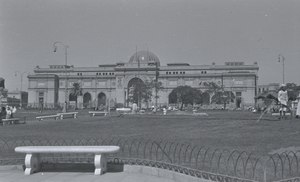Egyptian Museum
The Egyptian Museum (Lua error in package.lua at line 80: module 'strict' not found.
), also known as the Museum of Egyptian Antiquities, is located in Cairo, Egypt. It is home to an extensive collection of ancient Egyptian antiquities, with over 120,000 items on display. The museum was established in 1902 and has since become one of the most significant museums in the world dedicated to ancient Egyptian artifacts.
History
The Egyptian Museum was established by the Egyptian government in 1902 to house the vast collection of artifacts that had been discovered in various archaeological excavations throughout Egypt. The museum was designed by the French architect Marcel Dourgnon and is situated in Tahrir Square in Cairo.
Collections
The museum's collection includes artifacts from the Predynastic Period to the Greco-Roman Period. Some of the most notable items in the collection include the Tutankhamun collection, which features the famous golden mask of Tutankhamun, and the Narmer Palette, which is one of the earliest known depictions of an Egyptian king.
Tutankhamun Collection
The Tutankhamun collection is one of the most famous exhibits in the Egyptian Museum. It includes the golden mask of Tutankhamun, which is made of solid gold and inlaid with precious stones. The collection also includes the pharaoh's sarcophagus, throne, and various other items that were found in his tomb in the Valley of the Kings.
Royal Mummies
The museum also houses a collection of royal mummies, including those of Ramses II, Seti I, and Hatshepsut. These mummies provide valuable insights into the burial practices and mummification techniques of ancient Egypt.
Other Notable Artifacts
Other notable artifacts in the museum's collection include the Narmer Palette, the Mummy Mask of Psusennes I, and the Statue of Khafre. The museum also has a large collection of papyrus scrolls, jewelry, and funerary objects.
Architecture
The Egyptian Museum is an example of neoclassical architecture. The building features a large central hall with high ceilings and skylights, which allow natural light to illuminate the exhibits. The museum also has several smaller galleries and rooms that house specific collections.
Future Developments
The Egyptian government has announced plans to move the collection to the new Grand Egyptian Museum, which is currently under construction near the Giza Plateau. The new museum is expected to open in the near future and will provide a more modern and spacious environment for the display of Egypt's ancient treasures.
Related Pages
- Ancient Egypt
- Tutankhamun
- Valley of the Kings
- Ramses II
- Hatshepsut
- Giza Plateau
- Grand Egyptian Museum
Categories
Transform your life with W8MD's budget GLP-1 injections from $125.
W8MD offers a medical weight loss program to lose weight in Philadelphia. Our physician-supervised medical weight loss provides:
- Most insurances accepted or discounted self-pay rates. We will obtain insurance prior authorizations if needed.
- Generic GLP1 weight loss injections from $125 for the starting dose.
- Also offer prescription weight loss medications including Phentermine, Qsymia, Diethylpropion, Contrave etc.
NYC weight loss doctor appointments
Start your NYC weight loss journey today at our NYC medical weight loss and Philadelphia medical weight loss clinics.
- Call 718-946-5500 to lose weight in NYC or for medical weight loss in Philadelphia 215-676-2334.
- Tags:NYC medical weight loss, Philadelphia lose weight Zepbound NYC, Budget GLP1 weight loss injections, Wegovy Philadelphia, Wegovy NYC, Philadelphia medical weight loss, Brookly weight loss and Wegovy NYC
|
WikiMD's Wellness Encyclopedia |
| Let Food Be Thy Medicine Medicine Thy Food - Hippocrates |
Medical Disclaimer: WikiMD is not a substitute for professional medical advice. The information on WikiMD is provided as an information resource only, may be incorrect, outdated or misleading, and is not to be used or relied on for any diagnostic or treatment purposes. Please consult your health care provider before making any healthcare decisions or for guidance about a specific medical condition. WikiMD expressly disclaims responsibility, and shall have no liability, for any damages, loss, injury, or liability whatsoever suffered as a result of your reliance on the information contained in this site. By visiting this site you agree to the foregoing terms and conditions, which may from time to time be changed or supplemented by WikiMD. If you do not agree to the foregoing terms and conditions, you should not enter or use this site. See full disclaimer.
Credits:Most images are courtesy of Wikimedia commons, and templates, categories Wikipedia, licensed under CC BY SA or similar.
Contributors: Prab R. Tumpati, MD






